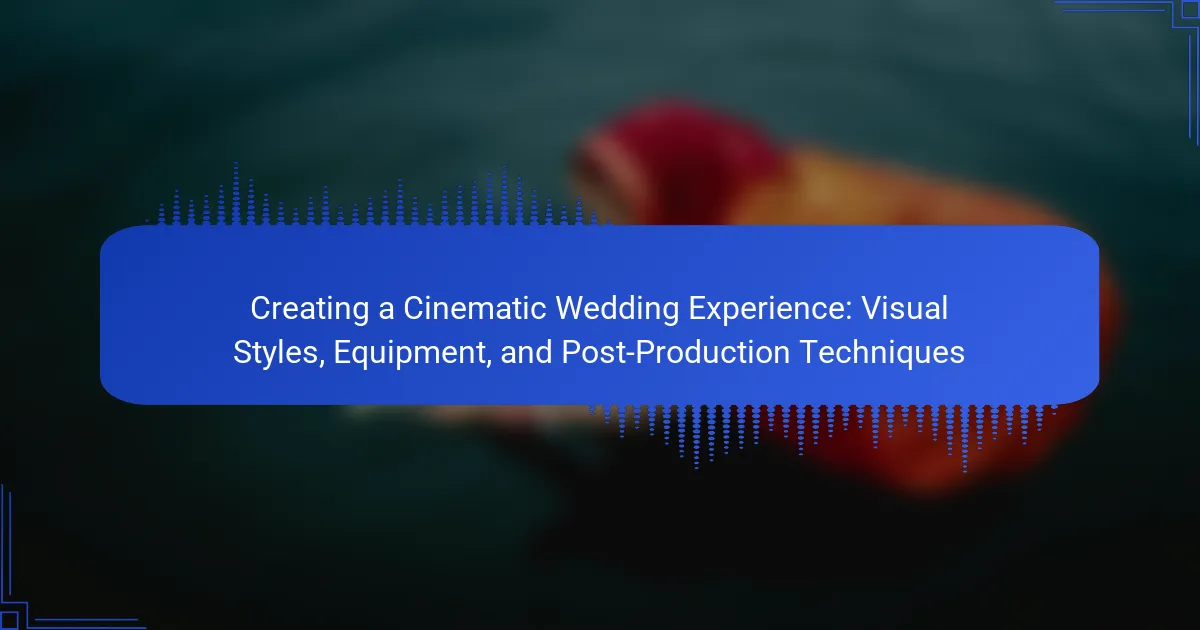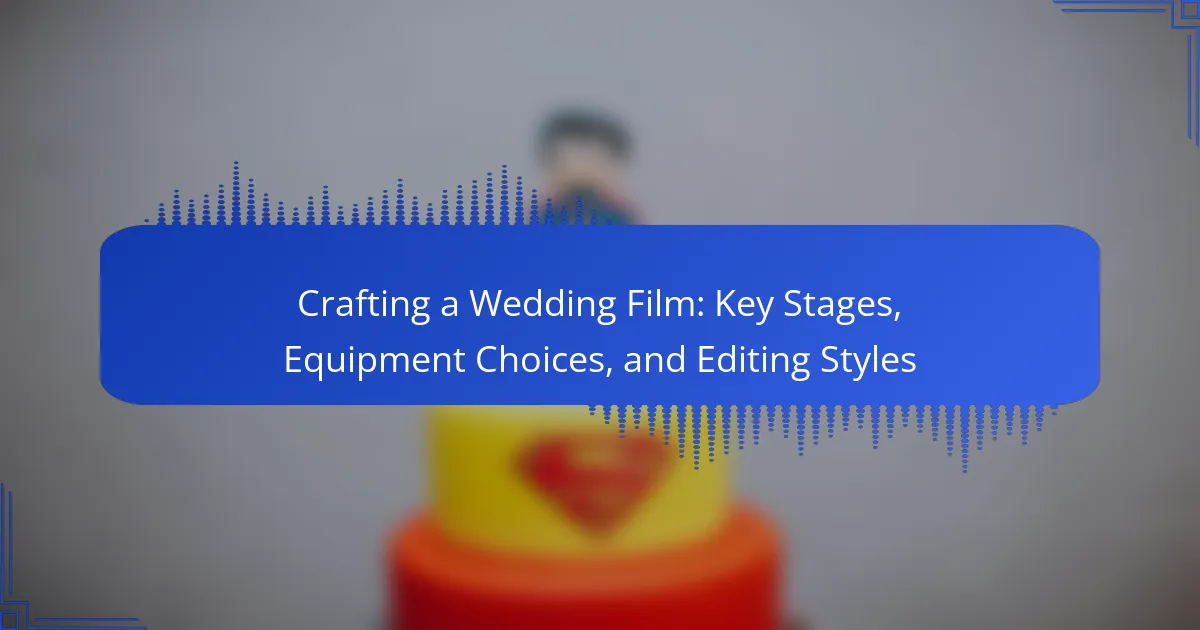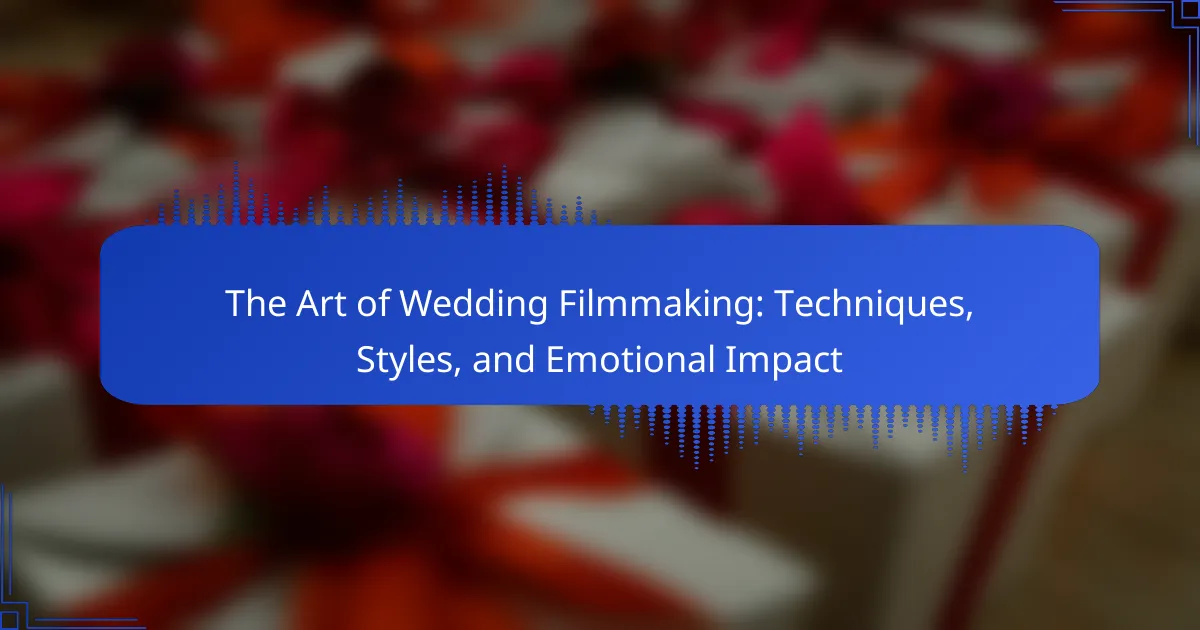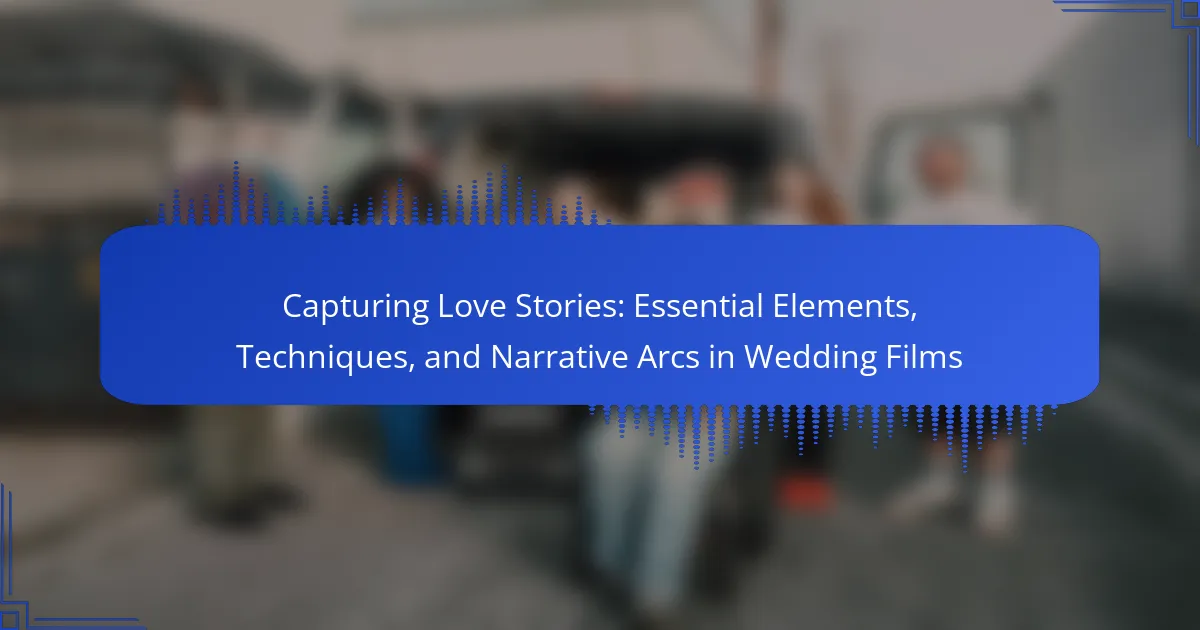A Cinematic Wedding Experience is a filmmaking approach that captures weddings with an emphasis on visual artistry and storytelling. This style utilizes dynamic camera movements, creative shot compositions, and cinematic techniques such as slow motion and aerial shots to produce a film that resembles a movie rather than a traditional wedding video. High-quality equipment, including professional cameras and lenses, is essential for achieving clarity and depth. Post-production techniques like color grading, sound design, and editing further enhance the final product, creating a memorable and emotionally impactful experience for viewers. The article outlines the key elements involved in creating a successful Cinematic Wedding Experience, including equipment, visual styles, and effective storytelling methods.
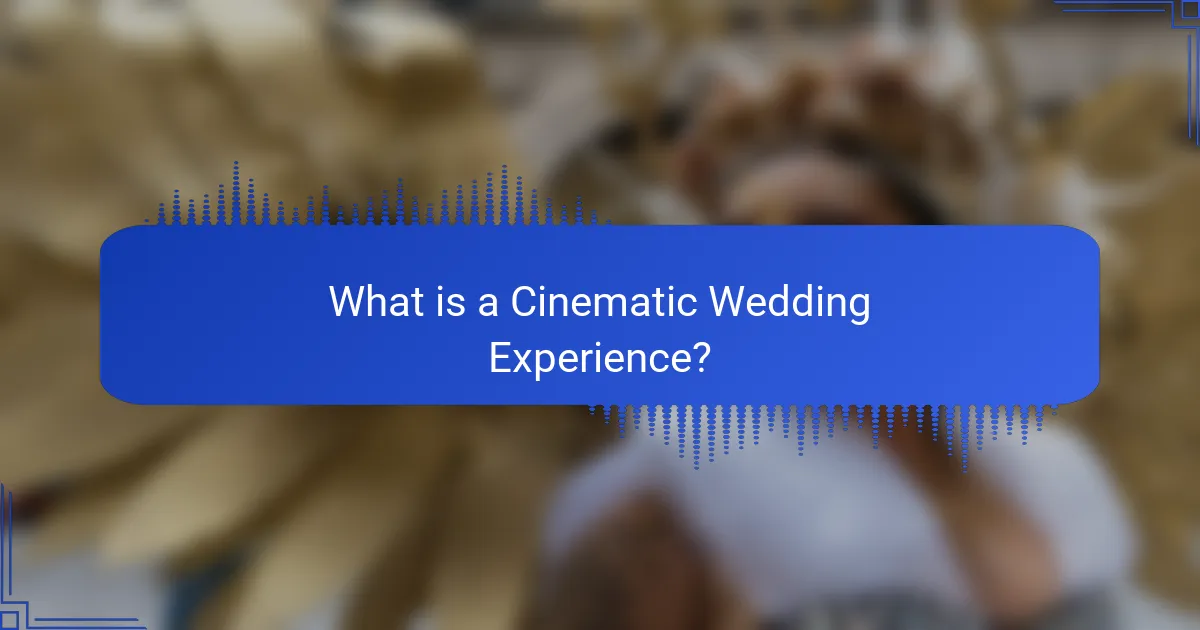
What is a Cinematic Wedding Experience?
A Cinematic Wedding Experience is a filmmaking approach that captures weddings in a visually artistic manner. This style emphasizes storytelling through dynamic camera movements and creative shot compositions. It often incorporates cinematic techniques like slow motion, aerial shots, and dramatic lighting. The goal is to create a film that feels more like a movie than a traditional wedding video. This experience typically uses high-quality equipment, including professional cameras and lenses. Post-production techniques enhance the final product with color grading and sound design. Couples often prefer this style for its ability to evoke emotions and preserve memories in a unique format.
How does a Cinematic Wedding Experience differ from traditional wedding videography?
A Cinematic Wedding Experience differs from traditional wedding videography primarily in its storytelling approach. Cinematic experiences focus on narrative-driven content, often resembling a film. They emphasize emotional moments, using techniques like slow motion and dramatic lighting. Traditional videography typically captures events in chronological order without a narrative arc. Cinematic productions often incorporate advanced equipment, such as drones and stabilizers, to achieve dynamic shots. Traditional videography may rely on standard camera setups, resulting in less visually engaging footage. Post-production in cinematic experiences includes color grading and sound design, enhancing the overall atmosphere. Traditional videos often have minimal editing, focusing on straightforward documentation. This distinction leads to a more immersive and artistic representation of the wedding day in cinematic experiences.
What visual storytelling techniques are commonly used in cinematic wedding experiences?
Cinematic wedding experiences commonly use techniques such as composition, lighting, and narrative structure. Composition involves framing shots to enhance storytelling. This technique captures emotions and important moments effectively. Lighting sets the mood and highlights key elements of the ceremony. It creates atmosphere and depth in the visuals. Narrative structure organizes the footage into a cohesive story. This approach guides viewers through the wedding day. Other techniques include slow motion for dramatic effect and aerial shots for unique perspectives. These methods combine to create an engaging visual narrative that resonates with viewers.
How does the emotional impact of cinematic wedding experiences compare to traditional formats?
Cinematic wedding experiences evoke a deeper emotional impact compared to traditional formats. Cinematic techniques utilize storytelling, music, and visual aesthetics to create a narrative that resonates emotionally. This approach often includes dynamic camera movements and creative editing, enhancing the viewer’s connection to the moments captured. Traditional formats typically focus on straightforward documentation, which may lack the emotional depth of a cinematic presentation. Research indicates that emotionally engaging storytelling can increase viewer retention and emotional response by up to 70%. This evidence supports the idea that cinematic experiences foster a more profound emotional engagement during and after the event.
What are the key visual styles in creating a Cinematic Wedding Experience?
Key visual styles in creating a Cinematic Wedding Experience include romantic, documentary, and artistic styles. The romantic style emphasizes soft lighting and dreamy compositions. It often uses close-ups to capture intimate moments. The documentary style focuses on candid shots and storytelling. This style aims to portray the day as it unfolds naturally. The artistic style incorporates creative angles and unique framing. It often includes dramatic contrasts and bold colors. Each style contributes to a personalized and memorable wedding film.
What are the different cinematic styles that can be applied to wedding videos?
Different cinematic styles can be applied to wedding videos, including documentary, cinematic, and vintage styles. Documentary style focuses on capturing real moments as they unfold. This style often features minimal direction and emphasizes authenticity. Cinematic style incorporates storytelling techniques and artistic visuals. It often uses dramatic lighting and creative angles to enhance emotional impact. Vintage style evokes nostalgia through color grading and retro effects. This style often mimics the look of older films. Each style offers a unique way to tell the couple’s story and creates lasting memories.
How do lighting and color grading enhance the visual style of wedding films?
Lighting and color grading significantly enhance the visual style of wedding films. Proper lighting creates mood and atmosphere, making scenes feel intimate or romantic. It highlights key moments, such as vows or first dances, drawing attention to emotions. Color grading adjusts the hues and tones, giving the film a cohesive look. This process can evoke specific feelings, like nostalgia or joy, enhancing the storytelling aspect. For example, warmer tones often create a sense of warmth and love. Studies show that visual aesthetics impact viewer engagement, making well-lit and color-graded films more memorable. The combination of these techniques elevates the overall quality and artistic expression of wedding films.
What equipment is essential for capturing a Cinematic Wedding Experience?
Essential equipment for capturing a Cinematic Wedding Experience includes a high-quality camera, a variety of lenses, and stabilizing equipment. A DSLR or mirrorless camera is crucial for high-resolution video. Prime and zoom lenses provide versatility for different scenes. A gimbal or steadicam stabilizes footage, ensuring smooth motion. Additionally, external microphones enhance audio quality, capturing vows and speeches clearly. Lighting equipment, such as softboxes or LED panels, helps create a flattering ambiance. Drones can capture stunning aerial shots, adding a unique perspective. Finally, backup storage devices are necessary for securing all footage.
What types of cameras are best suited for wedding cinematography?
DSLR cameras and mirrorless cameras are best suited for wedding cinematography. These cameras offer high-quality video capabilities and interchangeable lenses. DSLRs, like the Canon EOS 5D Mark IV, provide excellent low-light performance. Mirrorless options, such as the Sony A7 III, are compact and lightweight. Both types allow for manual control of settings, essential for dynamic wedding environments. Additionally, they support various frame rates for cinematic effects. Their versatility makes them popular among wedding videographers.
How do lenses and stabilization equipment affect the quality of wedding videos?
Lenses and stabilization equipment significantly enhance the quality of wedding videos. High-quality lenses capture sharp images with accurate colors. They allow for better low-light performance, essential for indoor or evening ceremonies. Different lenses offer unique perspectives, such as wide-angle for group shots or macro for details. Stabilization equipment, like gimbals or steadicams, minimizes camera shake. This results in smooth, cinematic footage that feels professional. A study by the Journal of Visual Communication found that stabilized footage is perceived as more engaging. Together, these tools elevate the overall production value of wedding videos.

How can post-production techniques enhance a Cinematic Wedding Experience?
Post-production techniques enhance a cinematic wedding experience by refining footage and adding artistic elements. Color grading adjusts hues and tones, creating a specific mood. This technique can evoke emotions, making moments feel more impactful. Editing allows for the selection of the best shots, ensuring a cohesive narrative. Transitions can create a seamless flow between scenes, enhancing storytelling. Sound design adds depth, incorporating music and effects that complement visuals. Visual effects can enhance scenes, making them more dynamic and engaging. These techniques ultimately elevate the overall quality, making the wedding film more memorable and enjoyable for viewers.
What are the key post-production processes involved in creating cinematic wedding films?
The key post-production processes involved in creating cinematic wedding films include video editing, color grading, audio mixing, and adding visual effects. Video editing is the process of selecting and arranging footage to tell a cohesive story. This typically involves cutting unnecessary scenes and enhancing the narrative flow. Color grading adjusts the color and tone of the footage to create a specific mood or aesthetic. Audio mixing balances dialogue, music, and sound effects for clarity and emotional impact. Adding visual effects can enhance specific moments, such as transitions or overlays. Together, these processes ensure a polished final product that captures the essence of the wedding day.
How does editing style influence the storytelling of a wedding video?
Editing style significantly influences the storytelling of a wedding video. It determines the pacing, mood, and emotional impact of the narrative. For instance, quick cuts can create excitement and energy, while slower transitions evoke a sense of intimacy and reflection. The choice of music and sound design further enhances the emotional resonance of the story. Color grading can set the tone, making scenes feel warm and romantic or cool and dramatic. Techniques such as montage can condense time, highlighting key moments in a concise manner. Ultimately, the editing style shapes how viewers connect with the couple’s journey, making it memorable and engaging.
What role does sound design play in enhancing the cinematic experience?
Sound design is crucial in enhancing the cinematic experience. It adds depth to visuals and evokes emotional responses. Well-crafted sound can immerse the audience in the story. It creates a sense of realism through ambient sounds and effects. Dialogue clarity is improved with effective sound design. Music underscores emotional moments, guiding viewer reactions. According to a study by the University of Southern California, sound influences viewer engagement significantly. This demonstrates that sound design is not merely an addition but a fundamental aspect of filmmaking.
What software is commonly used in the post-production of wedding films?
Adobe Premiere Pro is commonly used in the post-production of wedding films. It offers advanced editing features suitable for video projects. Final Cut Pro is another popular choice among wedding videographers. This software is known for its user-friendly interface and powerful editing capabilities. DaVinci Resolve is also frequently utilized for color correction and grading. Many professionals appreciate its comprehensive toolset for enhancing video quality. These software options are widely recognized in the industry for their effectiveness in creating polished wedding films.
What features should be considered when choosing editing software for wedding videos?
When choosing editing software for wedding videos, consider user-friendly interface, compatibility, and features. A user-friendly interface allows for efficient editing. Compatibility with various file formats ensures seamless workflow. Essential features include multi-camera editing, color correction, and audio editing tools. Multi-camera editing supports footage from different angles. Color correction enhances visual appeal and mood. Audio editing tools improve sound quality and synchronization. Additionally, consider export options for different resolutions and formats. These features collectively contribute to producing high-quality wedding videos.
How can color correction tools improve the final product of a wedding film?
Color correction tools enhance the final product of a wedding film by ensuring color accuracy and consistency. These tools adjust hues, saturation, and brightness to create a harmonious visual experience. They can correct lighting discrepancies that occur during filming. This results in a polished look that maintains the emotional tone of the event.
For example, skin tones can be refined to appear natural and appealing. Additionally, color grading can evoke specific moods, such as warmth for romantic scenes. Studies show that well-edited films engage viewers more effectively. Improved color quality can increase audience satisfaction and emotional impact.
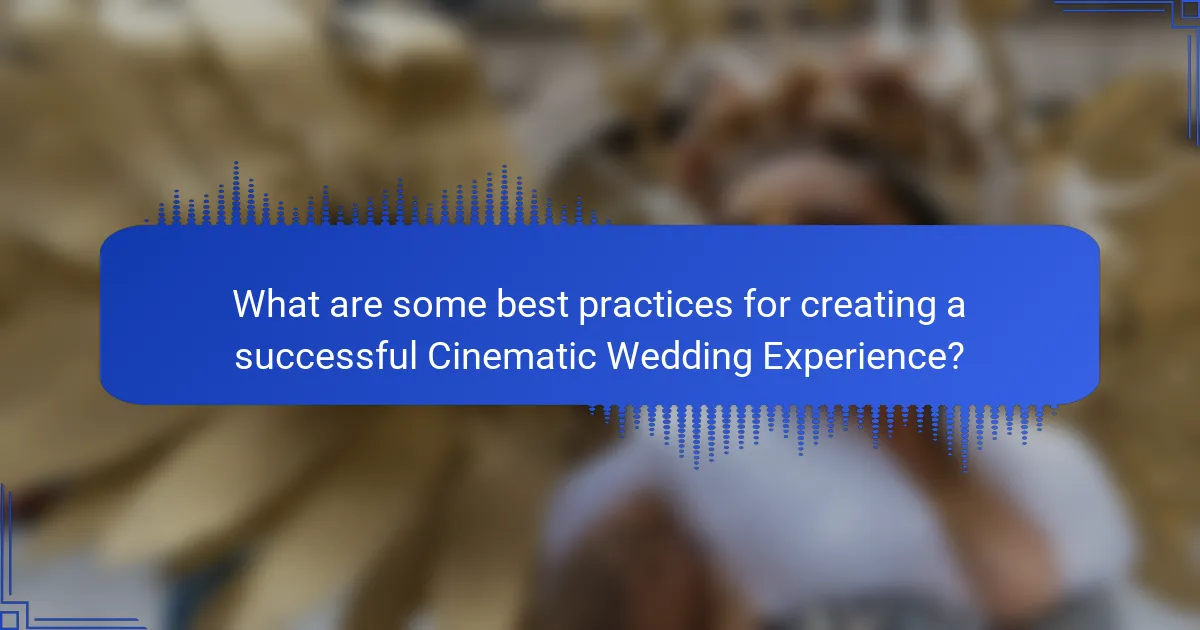
What are some best practices for creating a successful Cinematic Wedding Experience?
To create a successful Cinematic Wedding Experience, focus on high-quality visuals and storytelling. Use professional-grade cameras and lenses for clarity and depth. Plan your shots in advance to capture key moments. Incorporate natural light for a more authentic feel. Utilize stabilization equipment to ensure smooth footage. Engage with the couple to understand their vision and preferences. Edit with attention to pacing and emotion to enhance the narrative. According to industry standards, well-executed cinematic weddings can increase client satisfaction and referrals.
How can wedding filmmakers effectively collaborate with couples to achieve their vision?
Wedding filmmakers can effectively collaborate with couples by establishing clear communication from the beginning. This involves discussing the couple’s vision, preferences, and expectations in detail. Filmmakers should conduct pre-wedding consultations to understand the couple’s story and desired style. Utilizing mood boards or sample videos can help visualize concepts. Regular check-ins throughout the planning process ensure alignment. Filmmakers should also be open to feedback and willing to adapt their approach. By fostering a trusting relationship, filmmakers can create a more personalized and meaningful cinematic experience. This collaborative process often leads to a final product that resonates with the couple’s unique narrative.
What tips can help ensure a smooth filming process on the wedding day?
To ensure a smooth filming process on the wedding day, effective planning and communication are essential. Schedule a detailed timeline for the day’s events. Share this timeline with all vendors involved. Conduct a pre-wedding meeting with the couple and key participants. This helps clarify expectations and preferences. Designate a point person for the filming team. This person can assist with coordination and address any issues. Ensure all equipment is tested before the event. This minimizes technical difficulties during filming. Create a shot list based on the couple’s preferences. This ensures that important moments are captured. Lastly, maintain flexibility throughout the day. Adapt to any changes while keeping the couple’s vision in mind.
What common challenges do filmmakers face when creating cinematic wedding films?
Filmmakers face several common challenges when creating cinematic wedding films. Time constraints are significant, as weddings have a fixed schedule. This limits the time available for capturing all desired moments. Coordination with wedding planners and vendors can also be difficult. Miscommunication can lead to missed shots or undesirable footage.
Another challenge is managing lighting conditions. Weddings often occur in varying light environments, affecting video quality. Filmmakers must adapt quickly to these changes. Additionally, emotional moments can be unpredictable. Filmmakers need to be ready to capture genuine emotions without intruding.
Technical issues with equipment can arise unexpectedly. Filmmakers must ensure all gear is functioning properly before the event. Lastly, post-production can be time-consuming. Editing a cinematic wedding film requires meticulous attention to detail. Balancing artistic vision with client expectations is crucial for satisfaction.
How can filmmakers troubleshoot issues related to lighting and weather during the shoot?
Filmmakers can troubleshoot lighting and weather issues during a shoot by using several strategies. They should always have backup lighting equipment available. This includes reflectors, diffusers, and portable lights. Adjusting the shooting schedule can also help. Filmmakers can choose to shoot during golden hours for better natural lighting.
For weather-related challenges, having a contingency plan is essential. This may involve scouting indoor locations in advance. Filmmakers can also use weather apps to monitor conditions closely. If rain is expected, waterproof gear for equipment is crucial.
Using artificial lighting can compensate for unexpected weather changes. Filmmakers should be prepared with battery-powered lights for outdoor shoots. Additionally, they can adapt by utilizing natural elements like overcast skies to create soft lighting. These strategies ensure that filmmakers maintain control over their visual style despite external challenges.
What strategies can be employed to manage time effectively during the wedding day?
To manage time effectively during the wedding day, create a detailed timeline. A well-structured timeline outlines all key events and their durations. Assign specific time slots for each activity, from the ceremony to the reception. Communicate this timeline to all vendors and participants. This ensures everyone is on the same page regarding the schedule. Consider buffer times between events to accommodate any delays. Using a wedding coordinator can also help keep the day on track. They can manage the timeline and address any unexpected issues. Research shows that couples who plan their timelines effectively report a smoother wedding day experience.
What are the top tips for couples to prepare for a Cinematic Wedding Experience?
To prepare for a Cinematic Wedding Experience, couples should start by selecting a professional videographer experienced in cinematic storytelling. Researching their portfolio ensures alignment with the couple’s vision. Next, couples should create a detailed shot list, highlighting key moments they want captured. This helps the videographer understand priorities for the day. Additionally, couples should schedule a pre-wedding consultation to discuss themes and styles. This meeting allows for personalized adjustments to the shooting plan. Choosing the right location is also critical; scenic backdrops enhance the cinematic quality. Finally, couples should consider wardrobe choices that complement the visual style. Outfits with rich textures and colors can elevate the overall aesthetic.
How can couples communicate their vision effectively to their wedding filmmakers?
Couples can communicate their vision effectively to their wedding filmmakers by providing clear and detailed information about their preferences. They should create a mood board that includes images, colors, and styles they admire. Discussing specific moments they want captured helps filmmakers understand priorities. Couples should also share their love story to provide context for the film. Setting expectations regarding the final product, such as length and style, is crucial. Regular communication throughout the planning process ensures alignment. Providing examples of previous work from filmmakers they admire can clarify their vision. This approach leads to a more personalized and satisfactory cinematic experience.
What should couples consider when selecting locations for their wedding shoot?
Couples should consider the aesthetic appeal of the location for their wedding shoot. The backdrop should align with their desired visual style. Natural lighting conditions are crucial for quality photos. Accessibility for guests and vendors is also important. Couples should evaluate the venue’s rules regarding photography. Weather conditions can impact outdoor shoots, so alternatives should be considered. Privacy and intimacy of the location can enhance the overall experience. Lastly, the significance of the location to the couple can add sentimental value to the photos.
The main entity of the article is the Cinematic Wedding Experience, a filmmaking approach that captures weddings in a visually artistic manner, emphasizing storytelling through dynamic techniques. The article outlines key aspects including the differences between cinematic and traditional wedding videography, various visual storytelling techniques, the emotional impact of cinematic films, and essential equipment for capturing high-quality footage. It also discusses post-production processes that enhance the final product, best practices for filmmakers, and tips for couples to effectively communicate their vision and prepare for their wedding shoot. Overall, the article serves as a comprehensive guide to creating a memorable cinematic wedding experience.
